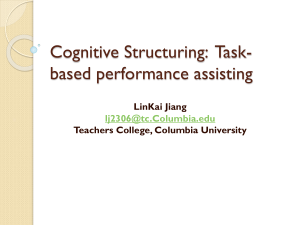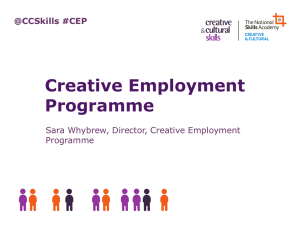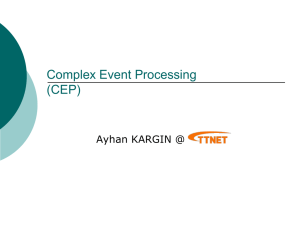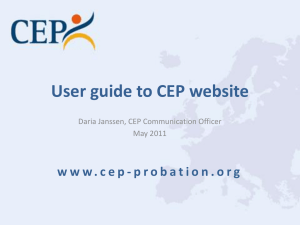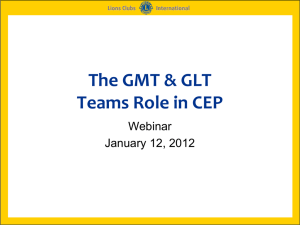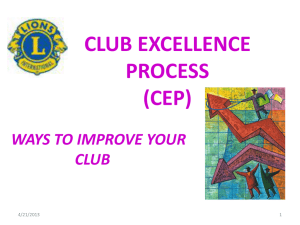CEP Intro SDL Part A Overview
advertisement
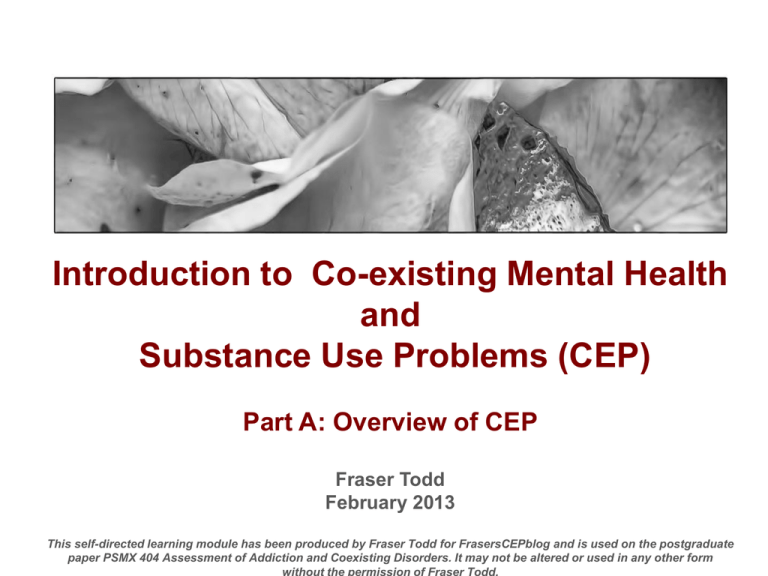
Introduction to Co-existing Mental Health and Substance Use Problems (CEP) Part A: Overview of CEP Fraser Todd February 2013 This self-directed learning module has been produced by Fraser Todd for FrasersCEPblog and is used on the postgraduate paper PSMX 404 Assessment of Addiction and Coexisting Disorders. It may not be altered or used in any other form without the permission of Fraser Todd. Copyright and Terms of Use: This SDL has been developed by Fraser Todd (University of Otago Christchurch, Matua Raki, Canterbury District Health Board) as an introduction to CEP and in particular to the models approaches I use. The module is best viewed in Microsoft Powerpoint as it contains links which not work in the PDF version. However, the content will be the same. If you are viewing it as a Powerpoint presentation, is best viewed as a slide show presentation. The font will be very small if viewed in slide sorter view. The content of this module, as with Te Ariari O Te Oranga, remains the intellectual property of Fraser Todd. Copyright is asserted over it. The ideas and content may be used freely for the purposes of education and clinical practice as long as the sources is cited in the usual way. Overview of this SDL Overview of this SDL Introductory Comments: This self-directed learning module on CEP is designed to provide and introduction and overview of my current approach and teaching on CEP as it stands in February 2013 (thinking is evolving rapidly in this area!). It draws on the content of Te Ariari O Te Oranga (Todd 2010) but updates it in crucial places to incorporate the development in thinking about some of the key points as they evolve through clinical practice and teaching and implementation. In places it is quite different to Te Ariari, in particular: • An increased emphasis on the context of practice, especially on brining the principles of person-centred care, wellbeing and recovery orientated practice and integrated care to the forefront and trying to make them live in practice, rather than just on the page. • An emphasis on practical application, especially the use of clinical strategies to implement the thinking. Where possible, brief strategies that can quickly be incorporated into a busy clinical workload are favoured. • Developments in thinking on motivation While you may feel you have a solid grounding in CEP, it is essential that you go through this introduction. It is especially important to note the sections on thinking about CEP and the Spirit of Te Ariari. These sections provide an essential ‘big picture’ context for CEP which is often missing from other models. The ‘big picture’ context is, I think, a key ingredient for working effectively with people with any complex health problem and especially with CEP. The sections on assessment and management have not been elaborated in this SDL. They are the core content of PSMX404 and will be taught in more depth during the course. Finally, this SDL should be read in the context of Te Ariari O Te Oranga. In parts, the SDL is a summary and more detail can be found in Te Ariari O Te Oranga. However, as mentioned, there have been developments in thinking since Te Ariari was released three years ago and these are covered in more detail in the SDL – where thinking differs between the two, consider the SDL an update. Overview of this SDL Use of This Material: The layout of this SDL includes pictures and diagrams. These represent the powerpoint slides used In the powerpoint presentation of this material in workshops. Information presented pictorial has been shown to significantly improve the understanding of written word or verbal content. They also enhance this SDL. One way this SDL can be used is to help you know the verbal content that accompanies each slide. This is useful if you are asked to undertake training in CEP and wish to use the powerpoint slide presentation that I have developed for my workshops in 2013. The powerpoint presentation will be made available to those who have completed PSMX404 or other training on the workshops and you may use it freely if you wish as long as it is cited appropriately (i.e I am acknowledged as the creator of the work). Overview of this SDL Table of Contents: Part A: Overview of CEP 1. Overview of this SDL module 2. CEP in NZ 3. The Spirit of Te Ariari O Te Oranga 2.1 Person-centred Care 2.2 Recovery and wellbeing-orientated care 2.3 Integrated care 2.4 Walking the Talk 4. Thinking about CEP 5. Background information 5.1 Definitions 5.2 The Nature of CEP 5.3 The History of CEP 5.4 Current approaches 5.5 The problem with current approaches 5.5 Stepped Care Part B: Update of Te Ariari O Te Oranga 6. Te Ariari O Te Oranga and the 7 Key Principles 6.1 Cultural Considerations 6.2 Recovery and Wellbeing 6.3 Motivation 6.4 Engagement 6.5 Assessment 6.6 Management 6.7 Integrated Care CEP in NZ CEP in NZ New Zealand has had an interest in CEP for at least the past decade. The first set of guidelines, The Assessment and Management of Co-existing Substance Use and Mental Health Disorders (Todd, Robertson & Selman) was produced in 1998 and since that time there has been continua attempts to promote CEP and ups-kill the workforce. This led to some consciousness raising, pockets of improved and enhanced practice, but in general there was a lot of resistance to change. There were several barriers to change. 1.While systems organisation was a major problem, organisations tended to approach CEP by simply providing some brief training for practitioners. In other words, there was a belief that improving treatments for people with CEP was simply a matter of clinicians getting better at their work. 2. There were widespread barriers to developing integrated approaches to care. Specifically, mental health and AOD practitioners held deep-seated negative attitudes towards each other. This was made worse by the prevailing view from practitioners that they works with MH problems or AOD problems and that the other was not their business. 3.Oragnisations tended to see CEP as a separate entity or specialty which required new resources, rather than than core business. CEP in NZ Many of the early training initiatives were strongly bicultural, undertaken in collaboration with the Moana House Training Institute in Dunedin. This infused CEP thinking with a strong bicultural influence. From around 2007, a renewed effort to promote CEP led to the development of service level initiatives (Integrated Solutions) alongside clinical framework (Te Ariari O Te Oranga) published in 2010 by the Ministry of Health (MOH). The MOH led the service level change through Jenny Wolf, a major influence on these developments. An advisory group in the MOH was estabished headed by the Director of Mehtal Heath and DHB’s were required to produce and implement action plans for enhancing services for people with CEP. Further, the national workforce development programmes, (Matua Raki, Te Pou, Te Rau Matatini) have collaborate to develop training, resources and networks. There now seems to be considerable momentum among clinicians nationally to develop their capability. Key factors underpin these changes. First, focusing on the person rather than the disorder and stressing well-being as a key outcome appears to have shifted attitudes away from a service and disorder focus. This has been the crucial factor in sparking developments. Second, practitioners collaborating around this person-centered focus has enhanced relationships between sectors. The Spirit of Te Ariari The Spirit of Te Ariari O Te Oranga Underpinning Te Ariari are a set of principles and values: • person-focused • wellbeing focused • integrated care • Walking the talk – many pay lip service to the concept of patient-focused care and wellbeing. It is seldom put into practice effectively. Thinking About CEP Thinking About CEP Simple-Complicated-Complex: Multi-dimensional problems involve so much information that it is difficult for clinicians to manage all the information they need to – they experience COGNITIVE OVERLOAD. Making sense of the information available becomes highly complicated. The response is usually to focus on certain parts or details of the problem they are familiar with. In the process, they miss important details, or fail to integrate them all, or lose site of the big picture. The key to managing complicated problems is to connect the details, to integrate them into a whole Complex things are multidimensional but manageable. In other words, making the complicated (confusing) complex (multi-faceted but able to be handled). Thinking About CEP Building Expert Knowledge Structures: While expert practitioners do know more detail, the key difference between them and novice practitioners is the connections they make between their pieces of knowledge. They integrate information by making connections and using frameworks to hang details from and integrate them. Thinking About CEP Learning About CEP: Similarly, learning about CEP is about using frameworks to integrate knowledge and skills. There are many frameworks that are useful. One example is the structure for the comprehensive assessment we promote. However, it is essential to begin with the ‘big picture’ frameworks. In the case of CEP (and most complex health problems), the overarching frameworks are those mentioned above that are the spirit of CEP: • Person-focused • Well-being orientated • Integrated care …put into practice These will be described in more detail in the next section. Frameworks Frameworks Person-focused Care: Not ‘patient/consumer/client’ centred (patient/consumer still define the person by their help-seeking role) Know the person in their social context - Values, belief and culture - Understand their hopes and aspirations (what well being means to them) Treat problems always in the context of persons values and vision of wellbeing Empower – partnership & participation Note that there is good evidence that taking a person-focused approach leads to better: • engagement • motivation, • treatment compliance • satisfaction with services (for both the help seeker and the help-giver) Frameworks Person-focused Care – Tools and Strategies: Identifying problems and implementing successful interventions are what, as clinicians, we do best. It is the heart of our work. However, to deliver person-focused care, we must always place this work in the context of the persons life and always remember that our ultimate aim is to help a person improve their overall quality of life. In clinical practice, a person-focused approach can be signaled very simply and quickly by beginning the initial contact with questions about the person, their social context, what matters to them in their life and their hopes and aspirations (what well-being means for them or what a good life would comprise of say, in a few years time). This doesn’t need to be detailed and extensive, though it can be. Simply starting with this approach, indicating its importance and noting that you will come back to these things later or in further sessions makes it clear to tangata whaiora that you are interested in them as a person and that the problem-focused questions that follow are place in the context of them as people. There are four interventions that can assist this process 1. Measuring treatment improvements by rating changes in overall quality of life: WHOQOL (100 item quetionnaire) WHOQOL-BREF (26 item questionnaire) and Identifying: 2. Personal values (Values Card Sort Execise or Questionnaire (Paper Version)) 3. Strengths (Character Strengths Assessment) 4. Identify Hopes, Aspirations &Wellbeing (Best Possible Self Exercise) Frameworks Well-being Orientated Care: People desire a state of flourishing; a high degree of wellbeing People seek help when there is discrepancy between there desired and their actual state of wellbeing – when they feel they are languishing. Well-being-orientated Care - Distress Well-being Orientated Care – Distress: They experience distress when they are languishing i.e there is a significant gap between their desired state of wellbeing and their actual state of wellbeing. This distress drives attempts to cope and then seek help if their ability to cope is insufficient to ease the distress Frameworks Well-being Orientated Care – Seeking Help: They try many strategies to improve their wellbeing before they seek help from us – specialist services. Specialist services therefore play a bit-part in the overall helping response. It is therefore important that specialist services understand that they play a part, but only a part in peoples journey Towards enhanced well-being. Specialist services serve – the organisation of those services must support the helping, rather than dominate it or be an end unto itself. Frameworks Well-being: Practitioner’s roles have become limited to specializing in removing specific barriers to wellbeing. The role of ‘support’ agencies has developed to ‘support’ the treatment of barriers to wellbeing. This is a small part of a person's overall movement towards increased wellbeing. We are well placed to help people take positive steps toward enhanced wellbeing, and even if we choose not to we should see our role as a part of the ‘bigger picture’. Why? People who are no longer sick are not necessarily well. - people with depression that has been treated and have no symptoms are less well than people whom never had depression. People who remain sick can enhance the positive aspects of their wellbeing to good effect. - people with chronic symptoms improve in a range of outcomes with wellbeing-orientated treatment Frameworks Integrated Care: Treatment integration = brining together the various treatments into a coherent system Integrated care = identifying the needs of tangata whaiora and organising systems seamlessly around them Integrated care comes from: • Understanding what wellbeing means for the tangata whaiora • Starting with the needs of tangata whaiora rather than the service • Considering both pathways to wellbeing and barriers to wellbeing (deficits) • Multi-dimensional integrated formulation using multiple paradigms • Leading to an integrated management plan and treatment • Systems that are oragnised to support integrated care Frameworks Integration - Tools and Strategies: There are a number of key points in the clinical process, which we can leverage to enhance integration. The tools and strategies we use clinically include: 1. Taking a wellbeing perspective 2. Screening and assessment processes that integrate a range of sources of information and information across multiple domains 3. Specific processes and structures within the assessment to integrate issues such as MH and AOD problems – timelines, ecograms 4. The process of forming an opinion and a multi-dimensional formulation 5. Combining of perspectives within the multi-disciplinary team 6. Collaboration with others outside the MDT Frameworks Walking the Talk: OR: Bringing these principles to life within the clinical relationship • We are well aware of many of these concepts • Indeed they may seem obvious and trite • However, they are not often put into practice • They need to become central principles or frameworks from which we organise and link the details of our knowledge • Clinical strategies to implement them need to be brief and easy to use (or they won’t be used) • These principles and strategies need to drive care, and systems should exist only to support and organise them. Background Information Background Information Definitions: • Coexisting substance use and mental health problems (CEP) are known by many different names. They all mean much the same thing. • The usual definition is the co-occurrence of mental health and substance use problems in the same person at the same time. • Research definitions often report lifetime rates of CEP; the person has MH and AOD problems at some point in their life, not necessarily at the same time. Current CEP in research usually means that the problems were present during the last month. Background Information The Nature of CEP: The Nature of CEP CEP is not a single thing. Rather, there are as many different subtypes as there are combinations of drugs and mental health problems. Problems related to CEP range from the simple and straightforward to the multi-dimensional and complicated. The more complicated cases of CEP are among the most difficult to treat and expose the weaknesses in the health system. generic As such, there are general or generic things that need to occur for all people with CEP, as well as specific things for each combination of MH and AOD problems. In almost all cases, when a MH problem is complicated by AOD problems, engagement, treatment outcome, suicide rates and psychosocial functioning are much worse. specific Background Information The Impact of CEP: CEP is associated with: • Poorer compliance • More relapses • More readmissions • Poorer outcomes • Treatment resistance • Increased rates of suicide and violence • Higher rates of unemployment Background Information General Epidemiology: Psychiatric Disorder % who suffer SUD CEP is common. Depressive 30 Bipolar 50 Schizophrenia 50 Antisocial PD 80 Anxiety 30 Bipolar disorder is the axis 1 disorder with the greatest rate of comorbid substance use problems. Phobic 25 Rates in those with antisocial personality disorder are up to 80%. In general terms, the rate of AOD problems in people with specific mental health disorders ranges from 25-30% for most anxiety disorders and major depression, to 50% of those with bipolar disorder and schizophrenia. Background Information NZ Epidemiology: Disorder Current Lifetime Onset (SD) 53% 73% 19 (10) 34% 44% 20 (11) 65% 77% 13(10) PTSD 31% 45% 19(11) Social Phobia 31% 37% 12 (7) Any Axis 1 74% 90% 13 (9) ASPD 27% 41% 9 (4)* Any Mood MDE Any Anxiety * Childhood conduct disorder In those in treatment for AOD problems, rates of comorbid MH disorders appear to be very high. A New Zealand study of two community AOD services showed that 90% had an axis I non-AOD DSMIV diagnosis in Mood and anxiety disorders were the most common. Of note just under a third had a current diagnosis of PTSD, and 10% had a current diagnosis of bipolar disorder, with less than half of them being in current mental health treatment. Also of note are the very low rates of psychosis in those with AOD problems, and even lower rates of schizophrenia. This is very important given the past emphasis in CEP on chronic psychotic disorders – they are uncommon. In this study, approxiamately 10% of the sample had a diagnosis of bipolar disorder. Most were not in the care of mental health services and approximately 50% were not on appropriate medication. N=105, From Adamson, Todd et al Aust NZ J Psychiatry 2006;40:164-170 Background Information The History of CEP: CEP is an ‘artifact’ of the way health problems are diagnosed and health systems structured. It emerged as an issue in the 1980s due to a number of developments in treatment, not least the move of clients from hospital to the community. Increased access to alcohol and drugs undoubtedly played a part, as did the advent of DSMIII and its insistence that if criteria for more than one diagnosis was met, all diagnoses should be made. Background Information The History of CEP: Large population studies such as the ECA and NCS studies also raised awareness of CEP and community mental health clinicians began reporting on the high prevalence CEP and the poor outcomes it was associated with. Most of the treatment models used today were developed during the early 1990s, most prominently those by Osher and Koefed, Drake, Carey and Mueser. At the heart of these models were the principles of comprehensiveness and integration. Background Information The History of CEP: During the 2000s, the need for widespread screening leading where appropriate to assessment was promoted and several treatment guidelines were published including TIP42 and the UK Dual Diagnosis Toolkit. These guidelines summarise the major ‘standard approaches’ to CEP that had been developed over the past decade and are considered ‘best practice’ Background Information Aetiology (Causes) – Traditional Views: It is usual to think of the aetiology or causes of CEP Involving three theoretical mechanisms: 1. Substance use causes mental health problems 2. Mental health problems cause substance use problems 3. Common factors underlying both lead to both occurring. … and to take the position that common factors are the most common reasons for CEP. However, the specific common factors are seldom described. There are several important considerations: 1. Prior to DSM (specifically DSMIII) , the usual approach to understanding mental health problems was to look for a single explanation rather than divide problems up into separate diagnoses. DSM changed this – it insisted that if criteria was met a diagnosis should be made leading to mutiople diagnoses 2. Over 50% of all people with mental health problems have more than one diagnosis. Co-morbidity is the rule rather than the exception 3. Systems issues and structures, as well as the increasing detail we have about problems has led to sub-specialisation, a narrow focus and silo-ing of services 4. CEP is an artifact that simply highlights the weaknesses in our systems and services Background Information Aetiology (Causes): In reality, the three mechanisms mentioned above all Together, and occur differently in different combinations of AOD and MH problems. Sometimes, the substance use may cause a mental health Syndrome. For example, psychosis due to cannabis use or stimulants (e.g. ‘P”) The presence of substance use may bring out the mental health worse in people who are predisposed to it, and make it worse Mental health problems may make the substance use worse and move it towards dependence Sometimes MH problems may drive the development of substance dependence and addiction. This is especially true of: •Bipolar disorder •PTSD •Socail phobia Often, both the two interaction mechanisms occur together Background Information Aetiology (Causes) – Common Factors: Underlying the interaction between mental health and substance use are the common factors mentioned in the previous slides. These are sometimes called trans-diagnostic factors; factors that underlie and contribute to many different Disorders and that increase the risk or cause multiple disorders. It is likely that these trans-diagnostic factors are responsible for a significant amount of the comorbitdity that exists. Some which are supported by evidence are listed in the diagram to the left. These factors are crucial in case formulation and should be targets of intervention if present. Failure to address these factors when present is highly likely to be a key factor in poor treatment response. Simply combining standard MH and AOD treatments may be a first Step for straight-forward cases of CEP, but will not be sufficient for the more complex cases. Background Information Standard Approaches to CEP – Core Components: There have been a variety of intervention models and programme types for CEP described in the literature. Core components of effective models include the following: • Comprehensiveness – assessing and addressing a broad range of concerns, not just immediate diagnoses • Treatment integration – combining MH and AOD treatments in a single package delivered by a single ‘team’ • Assertive Community follow-up • Staged interventions (engagement-persuasion or stages of change)- fitting treatment to the persons stage of change • MI + CBT – combining motivaional interviewing and CBT approaches • Harm reduction/minimisation – rather than insisting on abstinence from the outset, reduced use may be associated with better quality of life • Long-term perspective – treatment takes time and progress may fluctuate on its way to a good outcome • Recovery approach – going beyond a disorder focus to consider the person’s broader life, identity, social functioning • Integrated Continuous Systems of Care (Minkoff) • Fully integrated team • Multiple coordinated teams Background Information Current Approaches: At at programme level, there are two main approaches to CEP. Both stress the need to integrate MH and AOD treatments into a coherent package and incorporate similar components. 1. The first model focuses on developing a single programme, either residential or outpatient, which can address both mental health and substance use problems in an integrated way (a fully integrated team) 2. The second model, which is more widely developed involves collaboration across existing services to reduce the gaps between services and thereby integrating treatment (multiple integrated teams) These two approaches are not mutually exclusive. The first model produces highly skilled, CEP ‘enhanced’ teams. The second produces less skilled but arguably more flexible treatment. For most systems, the latter is more practical, given the high prevalence of CEP. Note that there are degrees of CEP capability. Some specialist teams will, however, benefit from being fully enhanced. Currently, services such as early psychosis intervention teams and some youth AOD/MH teams are CEP Enhanced. The diagram below (which we will return to later) presents a way of conceptualising the CEP capability of services Background Information Limitations of Current Approaches - Implementation: Best practice guidelines for CEP covering the standard approaches are outlined in TIP42 published by SAMHSA in 2005. It is an excellent resource and available free to download or order: http://www.ncbi.nlm.nih.gov/books/NBK64197/ However, the standard approach has a number of limitations. First, the ‘gold standard’ integrated dual diagnosis team approach of Drake and colleagues, as well as interventions such as motivation interviewing are very hard to put into practice in clinical settings with fidelity. Pejorative attitudes between MH and AOD clinicians remain significant barriers to implementation. Background Information Limitations of Current Approaches - Effectiveness: Second, after the release of TIP42, a number of systematic reviews have indicated that the best practice approaches are not effective in changing both MH and AOD problems, and that while these approaches have been shown to improve psychosocial functioning, they do not appear to change symptoms. The strongest evidence is for group approaches, long-term residential treatments and contingency management Background Information Limitations of Current Approaches - Engagement: Third, while there is some improvement in functioning with the standard CEP approaches, engagement remains highly problematic. Only 30-50% of people with severe CEP engage in treatment. Engagement and its closes relative, motivation, are crucial for good outcomes for people with CEP. Improvements in how we engage and motivate people may provide the best opportunities to improve CEP treatment. Background Information Limitations of Current Approaches - Constructs: Fourth, the standard treatments are built around the paradigms for treating chronic illnesses such as schizophrenia, which has a low rate of prevalence. They may not be applicable to other types of CEP. Most of the strategies for treating CEP involve change at the level of the service and system, such as bringing together AOD and MH treatments. At the clinical level there remains a lack of guidance for how to implement these change. Finally, integration is a key principle, but is usually thought of as integration of AOD and MH treatments. For most people with CEP, there is a lot more to integrate than just treatment for AOD and MH problems. People with CEP experience high rates of physical health problems which are often not addressed, problems with employment, finance, housing and so on. Each of these requires interaction with systems outside MH and AOD. Te Ariari O Te Oranga Te Ariari O Te Oranga The Assessment and Management of People with Co-existing Substance Use Problems Te Ariari O Te Oranga is the clinical framework for the treatment of people with CEP. It was published by the Ministry of Health in 2010 Te Ariari was designed as an update of an earlier set of guidelines (1998) but is significantly different in its attempt to provide an integrating framework that is person-centred and stresses wellbeing approaches to address generic issues, as well as detailed and specific approaches for specific subtypes of CEP. http://www.health.govt.nz/publication/te-ariari-o-te-oranga-assessment-and-management-people-co-existing-mentalhealth-and-drug-problems The 7 Key Principle and the CEP Frameworks Te Ariari is organized around 7 key principles: These principles are applied in each of five phases of treatment: 1.Cultural considerations 2. Wellbeing 3. Engagement 4. Motivation 5. Assessment 6. Management 7. Integrated Care 1. Pre-treatment 2. Early treatment 3. Middle treatment 4. Late treatment 5. Autonomous independence (These principles were chosen because they are the ones that require enhancing in the context of our current approaches to treatment. It is likely that in a few years, different principles will need stressing.) Thus the Te Ariari framework can be expressed as a matrix with related goals at each phase of treatment. Phases of Treatment, Key Goals and Strategies Referral from other services Not in another services Engagement Interview Pre-Treatment: Ascertain initial needs including cultural needs Ensure service and staff prepared to meet needs Early Treatment: Safety Values, Strengths, Personal definition of wellbeing Assessment Stabilisation Engagement From the 7 Key Principles, across the 5 Phases of Treatment, key goals ad strategies can be derived Middle Treatment: Active treatment of barriers and pathways to wellbeing Maintain engagement Late Treatment: Maintain gains Restore wellbeing Increasing self-care Autonomy: Self-motivation Self-responsibility Independence For details of strategies see Te Ariari pg Enhancing Service Capability Enhancing Service Capability Quadrants of Care: For the purposes of guiding service response to CEP, Ken Minkoff divides service by the severity of the MH and AOD problems they deal with and where people are best treated. The implications of this are that Q1 problems may be dealt with in primary care, Q4 problems probably require either shared care or CEP enhanced programmes able to treat both the MH and AOD problems they see, Q2 problems are best treated in an MH service with either some AOD skills or a collaborative relationship with an AOD service, and Q3 problems primarily treated in AOD service. This model is useful for guiding service planning with some caveats, especially that diagnosis may not be the best way to determine severity. Enhancing Service Capability Continuum of Service Capability: Where a service sits in the quadrants gives and indication of the CEP skills needed. The particular details of these skills will depend on the particular combinations of problems the service commonly deals with. Within this, services can rate themselves on a continuum of service capability, from MH or AOD only (where the other problem is seldom even recognised, through varying degrees of capability to CEP Enhanced. A CEP enhanced service would be one capable of assessing and managing the CEP it sees with a high level of skill and without needing to collaborate with other services. The majority of services do not need to be CEP Enhanced. As mentioned, there are degrees of CEP Capability. The aim is for services to determine what level of capability they wish to have and develop themselves to achieve that. There are service rating tools available to help with this process. Enhancing of Service Capability Determinants of Service Capability: One way of thinking about levels of CEP Capable services and guiding service development is that at the most basic level of capability, a service is able to screen for and detect the vast majority of the ‘other’ problems. A higher level of capability involves the ability of a service to not only screen for but also undertake a comprehensive assessment of both MH and AOD problems. The highest level of capability, after which a service would be considered enhanced, involves the ability to not only undertake an effective comprehensive assessment, but also to develop an effective management plan. They would still need to collaborate with others to provide that management. Enhancing of Service Capability Collaboration to Enhance Capability: As noted, a CEP Capable service is able to provide some degree of screening, assessment or management planning. At the point that their capability is exceeded, they will need to collaborate with other services. Integrated care goes beyond MH and AOD integration to involve areas such as physical health, Housing and education and employment. Ultimately all services need to collaborate with others to ensure comprehensive and integrated care. Enhancing of Service Capability Developing Capability: As a service enhances its capability, the specific needs of collaboration change. Enhancing of Service Capability System Wide Development Model: This diagram shows one model of systems wide enhancement of CEP capability. This model is currently being applied in the Canterbury District Health Board. It is comprised of three related parts: 1. Across-service Generic Training Content: An overview of CEP based on Part A of this SDL. The key content is the philosophy of patientfocused and wellbeing orientate care, including some practical clinical strategies. Delivery: A series of workshops for clinicians/managers from a variety of services + a train-the-trainers approach to disseminate the information more widely across the DHB. Six subsequent workshops on the 7 Key Principles (Part B of the SDL) 2. Service-based Training Content: Reinforcement of Part A philosophy of this SDL and detailed learning on the 7 Key Principles of Te Ariari as Delivery: Initial workshop plus in-service training 3. Collaborative Learning Content: Reinforcement of the above content on a caseby-case basis Delivery: AOD liaison staff placed in MH services involved in collaborative or shared care. Tools for Enhancing Practitioner & Service Capability Tools for Practitioner & Service Capability System Wide Development Model: A number of tools have been produced to help services and practitioners self-assess their CEP capability: 1. Co-existing Problems (CEP) Resource Map Part of the Te Pou website which includes a links to a large number of local resources CEP relevant resources 2. Co-existing Problems (CEP) Service Checklist A checklist approach to service self-assessment of CEP capability developed by Matua Raki (National Addiction Workforce Development Centre 3. Co-existing Problems (CEP) Tools and Resources Downloadable PDF listing and linking to a range of local and international CEP resources and readings.
